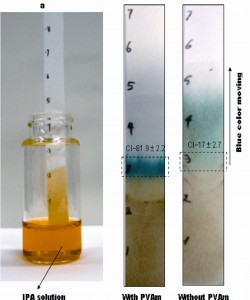12
Nov
New, Inexpensive “Dipstick” Can Test for Pesticides in Food
(Beyond Pesticides, November 12, 2009) Scientists from McMaster University in Hamilton, Ontario have developed a dipstick test that can detect minute amounts of toxins and pesticides in foodstuffs that is slated to be less costly than current pesticide testing methods and can produce results within minutes. Their paper-strip test produces results in minutes rather than hours by means of an easy-to-read color-change.
Published in the November 1 issue of the American Chemical Society’s Analytical Chemistry, a semi-monthly journal: “Reagentless Bidirectional Lateral Flow Bioactive Paper Sensors for Detection of Pesticides in Beverage and Food Samples,” study author, John Brennan, PhD, and colleagues note that conventional tests for detecting pesticides tend to use expensive and complex equipment and in some cases can take several hours to produce results. They cite a growing need for cheaper, more convenient, and more eco-friendly tests for pesticides, particularly in the food industry.A 10 cm-long bioactive paper-based solid-phase biosensor was developed to detect acetylcholinesterase (AChE) inhibitors, including organophosphate pesticides. The researchers tested this sensor using food and beverage samples intentionally contaminated with common pesticides. The strip accurately detected trace amounts of the chemicals within five minutes, according to the scientists. The test strip changes color shades (a yellow-to-blue color change) depending on the amount of pesticide present. Also noteworthy is that the sensor is able to detect any AChE inhibitor, not just pesticides and may have potential applications in the study of neurodegenerative diseases, such as Alzheimer’s disease.
Their results were consistent with those of conventional analytical methods. The researchers also found that the sensor strips remained viable during storage over a period of at least 1 month when stored at 4 °C, demonstrating sufficient shelf life for storage and shipping.
“The tests could be most useful in developing countries and in the market of imported fruits and vegetables as well as in rural settings for on-site testing where testing equipment is not available or there’s no electricity,” said Dr. Brennan in an interview. He added that a number of regulatory hurdles and scale-up issues remain before the dipstick would be available. Each strip could cost as little as 25 cents and could also be adapted to test for toxins in water or even for E-coli before it enters the food chain.
Pesticide regulations in the United States set limits for pesticide levels found in fruits, vegetables and drinking water and under the Food Quality Protection Act (FQPA), the U.S. Environmental Protection Agency (EPA) must assess the cumulative risks of pesticides including exposures from food and drinking water and set chemical tolerances (the maximum amount of pesticide residue allowed to remain on food products) for pesticides. However, the cumulative effects of these allowed pesticide residues are not fully evaluated, nor are cumulative exposures to a mixture of many different pesticides and other toxics.
For this reason, Beyond Pesticides advocates for organic foods. Studies have found that diet is the primary route of exposure to pesticides, especially in children, and that switching to an organic diet decreases exposure substantially.
Source: American Chemical Society












Are the public allowed to buy these, I would luv them.
November 12th, 2009 at 11:10 pmNo – apparently this is the only article about this. They probably murdered the inventors and burned the patent, you can be sure of it.
March 6th, 2012 at 1:38 amwho is the company making the dipstick? if only the researchers were named then we could track them down and make it more public!!!!!!
September 12th, 2013 at 9:21 pmI am a teacher and would like a set of these for students. Are they available for purchase?
August 23rd, 2015 at 7:38 pm